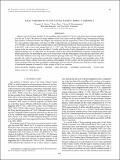| dc.contributor.author | Schulz, Norbert S. | |
| dc.contributor.author | Testa, Paola | |
| dc.contributor.author | Huenemoerder, David P. | |
| dc.contributor.author | Ishibashi, Kazunori | |
| dc.contributor.author | Canizares, Claude R. | |
| dc.date.accessioned | 2012-08-17T19:54:47Z | |
| dc.date.available | 2012-08-17T19:54:47Z | |
| dc.date.issued | 2006-08 | |
| dc.date.submitted | 2006-07 | |
| dc.identifier.issn | 0004-637X | |
| dc.identifier.issn | 1538-4357 | |
| dc.identifier.uri | http://hdl.handle.net/1721.1/72201 | |
| dc.description.abstract | Massive stars rarely show intrinsic X-ray variability. One exception is θ[superscript 2] Ori A, which has shown strong variability over the last 5 years. We observed a large outburst of the X-ray source with the High Energy Transmission Grating Spectrometer on board Chandra and compare the emissivity and line properties in states of low and high flux. The low state indicates temperatures well above 25 MK. In the high state we find high emissivities in the range from 3 to over 100 MK. The outburst event in stellar terms is one of the most powerful ever observed and the most energetic one in the ONC, with a lower total energy limit of 1.5 × 10[superscript 37] ergs. The line diagnostics indicate that the line-emitting regions in the low states are as close as within 1-2 stellar radii from the O star's photosphere, whereas the hard states suggest a distance of 3-5 stellar radii. We discuss the results in the context of stellar flares, magnetic confinement, and binary interactions. By matching the dates of all observations with the orbital phases of the spectroscopy binary orbit, we find that outbursts occur very close to the periastron passage of the stars. We argue that the high X-ray states are possibly the result of reconnection events from magnetic interactions of the primary and secondary stars of the spectroscopic binary. Effects from wind collisions seem unlikely for this system. The line properties in the low state seem consistent with some form of magnetic confinement. We also detect Fe fluorescence indicative of the existence of substantial amounts of neutral Fe in the vicinity of the X-ray emission. | en_US |
| dc.description.sponsorship | United States. National Aeronautics and Space Administration. (Smithsonian Astrophysical Observatory) (Contract Number SV3-73016) | en_US |
| dc.description.sponsorship | United States. National Aeronautics and Space Administration. (Contract Number NAS 8-03060) | en_US |
| dc.language.iso | en_US | |
| dc.publisher | IOP Publishing | en_US |
| dc.relation.isversionof | http://dx.doi.org/10.1086/508625 | en_US |
| dc.rights | Article is made available in accordance with the publisher's policy and may be subject to US copyright law. Please refer to the publisher's site for terms of use. | en_US |
| dc.source | arVix | en_US |
| dc.title | X-Ray Variability in the Young Massive Triple θ2 Orionis A | en_US |
| dc.type | Article | en_US |
| dc.identifier.citation | Schulz, Norbert S. et al. “X-Ray Variability in the Young Massive Triple θ2 Orionis A.” The Astrophysical Journal 653.1 (2006): 636–646. | en_US |
| dc.contributor.department | MIT Kavli Institute for Astrophysics and Space Research | en_US |
| dc.contributor.approver | Canizares, Claude C. | |
| dc.contributor.mitauthor | Schulz, Norbert S. | |
| dc.contributor.mitauthor | Testa, Paola | |
| dc.contributor.mitauthor | Huenemoerder, David P. | |
| dc.contributor.mitauthor | Ishibashi, Kazunori | |
| dc.contributor.mitauthor | Canizares, Claude R. | |
| dc.relation.journal | Astrophysical Journal | en_US |
| dc.eprint.version | Author's final manuscript | en_US |
| dc.type.uri | http://purl.org/eprint/type/JournalArticle | en_US |
| eprint.status | http://purl.org/eprint/status/PeerReviewed | en_US |
| dspace.orderedauthors | Schulz, Norbert S.; Testa, Paola; Huenemoerder, David P.; Ishibashi, Kazunori; Canizares, Claude R. | en |
| dc.identifier.orcid | https://orcid.org/0000-0002-5769-8441 | |
| mit.license | PUBLISHER_POLICY | en_US |
| mit.metadata.status | Complete | |
